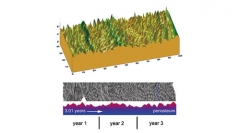

 Comptes Rendus Palevol
10 (5-6) - Pages 499-507
Comptes Rendus Palevol
10 (5-6) - Pages 499-507Of the major contributions to our understanding of the skeleton made by Armand de Ricqlès is the notion that within the microanatomy of bone we may observe “signals”, some relating to phylogeny, and others to aspects of growth, function, and physiology. We are motivated to follow this road, as it were, and read the “signposts” along the way. Incremental structures are such signposts, representing biological rhythms as successive forming fronts in enamel and bone. A long period rhythm in humans, which occurs on average every eight to nine days, is observed in enamel as the stria of Retzius and in bone as the lamella. Because lamellae are formed within defined periods of time, quantitative measures of widths of individual lamellae provide time-resolved growth rate variability. Results obtained on primary incremental lamellar bone from midshaft femur histological sections of sub-Saharan Africans of Bantu origin and known life history reveal environmental effects heretofore unknown.
Enamel striae of Retzius, Lamellar bone, Growth rhythms